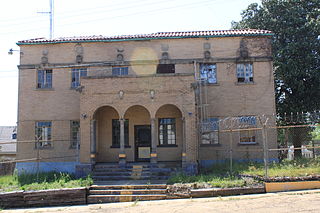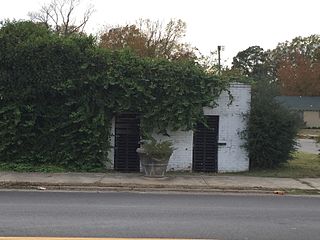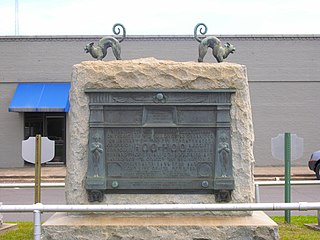
The T.G. Richards and Company Store, also known as Whatcom County Courthouse and James B. Steadman Post No. 24, is the first and oldest brick building in the state of Washington, United States, and is listed on the U.S. National Register of Historic Places.

The Washington County Courthouse is the name of a current courthouse and that of a historic one in Fayetteville, Arkansas, the county seat of Washington County. The historic building, built in 1905, was listed on the National Register of Historic Places in 1972. The historic courthouse is the fifth building to serve Washington County, with the prior buildings located near the Old Post Office on the Historic Square. The building is one of the prominent historic buildings that compose the Fayetteville skyline, in addition to Old Main.

The Boone County Courthouse is a historic courthouse in Harrison, Arkansas. It is a two-story brick structure, designed by noted Arkansas architect Charles L. Thompson and built in 1907. It is Georgian Revival in style, with a hip roof above a course of dentil molding, and bands of cast stone that mark the floor levels of the building. It has a projecting gabled entry section, three bays wide, with brick pilasters separating the center entrance from the flanking windows. The gable end has a dentillated pediment, and has a bullseye window at the center.

The Boone County Jail is a historic jail building at Central Ave. and Willow St. in Harrison, Arkansas. It is a two-story red brick building, built in 1914. Its design has been attributed to prominent Arkansas architect Charles L. Thompson. Its hip roof is finished in red tile, as is the roof of the single-story porch sheltering the main entrance. The jail was laid out to house the jailer on the first floor, and the prisoners on the second.

The Columbia County Jail is a historic structure at Calhoun and Jefferson Streets in Magnolia, Arkansas. The brick two story structurewas designed by Thompson & Harding and was built c. 1920, and is an excellent local example of Italian Renaissance architecture. It is faced in cream-colored brick, and has a terracotta hipped roof. It has an entrance portico with round arches supported by slender columns and gargoyles at its corners.

The Menominee County Courthouse is a government building located on Tenth Avenue between Eighth and Tenth Streets in Menominee, Michigan. It was listed on the National Register of Historic Places in 1975 and designated a Michigan State Historic Site in 1974.

Powhatan Historic State Park is a 9.1-acre (3.7 ha) Arkansas state park in Lawrence County, Arkansas in the United States. The park contains the 1888 Powhatan courthouse which served as the home of county government from 1869-1968. Today the structure displays items of cultural and historical significance and hosts the park's Visitor Center. The park includes four additional historical buildings and the Arkansas History Commission's Northeast Arkansas Regional Archives. A tour of the historic structures is available. Powhatan served as an important stop for traffic on the Black River until the installation of the Kansas City-Memphis Railwayline two miles north in 1883 significantly decreased the need for river transportation.

Hermitage City Hall and Jail is a historic building at 112 South Oak Street in Hermitage, Arkansas. A modest single story yellow brick building probably built in the 1940s, its front section served as Hermitage City Hall, and the rear as the city jail, until 2000.

The former McGehee City Jail is a historic building at South First and Pine Streets in McGehee, Arkansas. The small single story brick building was built in 1908, and served as the city jail until 1935. The building's roof is made of concrete, and it has three cells, each with a separate outside door. All openings in the building are covered with heavy metal bars, and the doors are solid metal. Even though this building has sat vacant since 1935, it has survived the jail that was built to replace it.

The Horace Estes House is a historic house at 614 East Main Street in Gurdon, Arkansas. It is a single-story structure with a wood frame and brick veneer exterior. It was built in 1934, and is the city's best example of Tudor Revival architecture, featuring an irregular plan, multiple gables in the roofline, a tall ornamental chimney, and narrow windows.

The Hoo Hoo Monument on First Street in Gurdon, Arkansas, is a commemoration of the creation of the International Concatenated Order of the Hoo Hoo, a fraternal society of lumbermen founded in Gurdon in 1892. The granite monument with bronze plaque is located near the site of the Hotel Hall where the Hoo Hoo organization was founded. The monument was designed in the Egyptian Revival style by George Zolnay and placed in 1909. The plaque was originally affixed to Hotel Hall, but was moved to the granite marker after the building was demolished in 1927. The monument is a rare Arkansas work by Zolnay.

The Missouri-Pacific Railroad Depot-Gurdon is a historic railroad station building at North 1st Street and East Walnut Street in Gurdon, Arkansas. The single-story masonry building was built c. 1917 by the Missouri-Pacific Railroad to house passenger and freight service facilities. It is built in the Mediterranean Renaissance style which was then popular for building such structures in Arkansas. It has a red clay tile roof, Italianate bracketing, and Baroque quoin molding.

The June Sandidge House is a historic house at 811 Cherry Street in Gurdon, Arkansas. It is a single-story wood-frame house with a brick veneer exterior, and represents an excellent and unusual local example of English Revival architecture. The house was built in 1938 by Mr. June Sandidge, an engineer for the Missouri Pacific Railroad. Its styling is essentially vernacular English Revival, although there are some Mediterranean influences, including Spanish-style arches on the porch.

The Old Gillett Jail is a historic former city jail at 207 Main Street in Gillett, Arkansas. It is a single-story brick structure, housing two cells and a small entry vestibule. Its windows have vertical iron bars over them, and the door is made of solid metal. The roof is made of metal. It was built in 1922, and served as the city jail until about 1972.

The former West Memphis City Hall is a historic municipal building at 100 Court Street in West Memphis, Arkansas. It is a brick building, whose original 1938 construction consisted of two two-story sections joined by a single-story connector. The front portion of the building housed city offices, while the rear portion housed the fire station and the jail. It was built in 1938 with funding from the Public Works Administration, a Depression-era jobs program. The building was extended to include a courtroom annex in 1944–45, and an enlarged jail annex was added in 1960–61. It no longer houses town offices ; it now houses a police dispatch center and the municipal court.

The Mississippi County Jail was a historic county jail building in Osceola, Arkansas. It was a three-story brick structure, six bays wide, with entrances at the outer two bays, which projected slightly and were set off from the central portion by brick pilasters and a decorative parapet at the roof line. The county built the jail in 1926; it was demolished in 2016.

The Rector Waterworks Building is a historic civic building at 703 South Main Street in Rector, Arkansas. It is a single-story brick building, with a false gabled front masking a flat roof. The front facade is three bays wide, with the outer bays filled with pairs of round-arch windows. The center bay has a slightly recessed double-door entry, with a sheltering gable-roofed portico which is supported by brick piers. The bays are separated by brick pilasters. The building was erected c. 1928 as part of the city's first water supply system. For a period of about 15 years the building also served as the local jail.

The Benton County Jail is a historic county jail building at 212 North Main Street in Bentonville, Arkansas, United States. It is a two-story brick Classical Revival building, designed by A. O. Clark and completed in 1911. It has pronounced limestone corner quoining, and its main entrance is flanked by Ionic columns and topped by a gabled pediment. The building is notable as a rare smaller-scale work by Clark.

The Old Central Fire Station is a historic former fire station at 506 Main Street in North Little Rock, Arkansas. It is a two-story brick building, with a three-bay front facade dominated by a large equipment bay on the ground floor, now enclosed by glass doors. The building, whose construction date is not known, was acquired by the city in 1904, shortly after its incorporation, and initially housed city offices, the jail, and the fire station. In 1914 the town offices were moved to North Little Rock City Hall, and in 1923 the building's original two equipment bays were replaced by one. The horse stalls were also removed, as the new equipment was powered by gasoline engines. The building served as the city's main fire station until 1961.

The Old Logan County Jail is a historic government building at 202 North Vine Street in Paris, Arkansas. It is a two-story brick building, covered by a hip roof with exposed rafter ends. Its main facade has a single-story porch extending across the front. Windows are set in segmented-arch openings, with strap-metal bars set across them in a crosshatch pattern. There are two entrances, one for the jailer's quarters, and one with bars that provides access to the cell block. Built in 1903, it is one of the state's best-preserved early 20th-century county jails. It is the site of the last legal hanging in Arkansas, which took place when John Arthur Tillman, 23, was hung on July 15, 1914 at 7 am for the murder of Amanda Jane Stephens, 19.




















